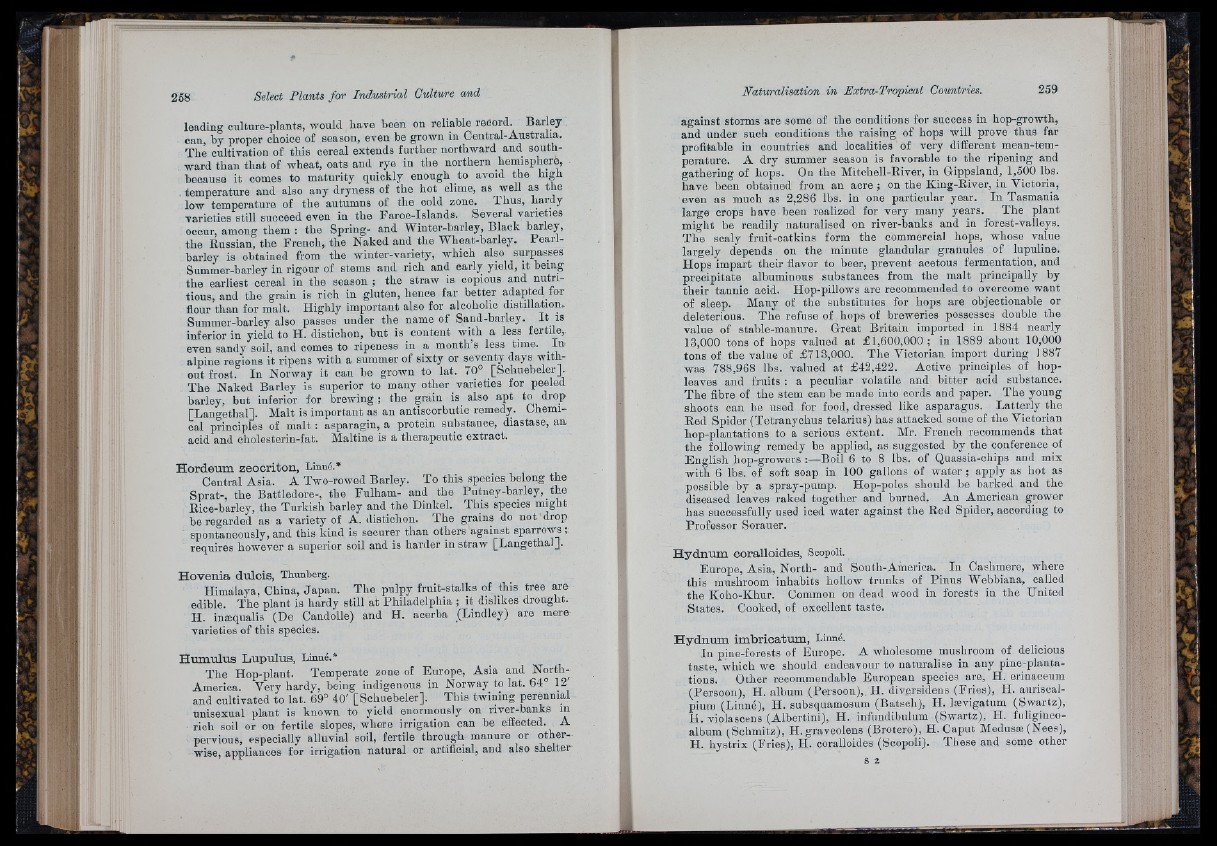
258 Select Plants fo r Industrial Culture and
¥ J i
leading culture-plants, would have been on reliable record. Barley
can, by proper choice of season, even be grown in Central-Australia.
The cultivation of this cereal extends further northward and southward
than th a t of wheat, oats and rye in the northern hemisphere,
because it comes to maturity quickly enough to avoid the high
temperature and also any dryness of tbe hot clime, as well as the
low temperature of the autumns of the cold zone. Thus, hardy
varieties still succeed even in the Faroe-Islands. Several varieties
occur, among them : the Spring- and Wiuter-harley, Black barley,
the Russian, the French, the Naked and the Wheat-barley. Pearl-
barley is obtained from the winter-variety, which also surpasses
Summer-barley in rigour of stems and rich and early yield, it being
the earliest cereal in the season ; the straw is copious and nutritious,
and the grain is rich in gluten, hence far better adapted for
flour than for malt. Highly important also for alcoholic distillation.
Summer-barley also passes under the name of Sand-barley. I t is
inferior in yield to H. distichon, but is content with a less fertile,,
even sandy soil, and comes to ripeness in a month’s less time. _ In
alpine regions it ripens with a summer of sixty or seventy days without
frost. In Norway it can be grown to lat. 70° [Scbuebeler].
The Naked Barley is superior to many other varieties for peeled
barley, but inferior for brewing; the grain is also apt to drop
[Langethal]. Malt is important as an antiscorbutic remedy. Chemical
principles of malt : asparagin, a protein substance, diastase, an
acid and cholesterin-fat. Maltine is a therapeutic extract.
H o r d e u m z e o c r ito n , Linné.*
Central Asia. A Two-rowed Barley. To this species belong the
Sprat-, the Battledore-, the Fulham- and the Putney-barley, _ the
Eice-bariey, the Turkish barley and the Dinkel. This species might
be regarded as a variety of A. distichon. The grains do not drop
spontaneously, and this kind is securer than others against sparrows ;
requires however a superior soil and is harder in straw [Langethal].
H o v e n i a d u lc is , Thunberg.
Himalaya, China, Japan. The pulpy fruit-stalks of this tree are
edible. The plant is hardy still at Philadelphia ; it dislikes drought.
H. inæqualis (De Candolle) and H. acerba (Lindley) are mere
varieties of this species.
H u m u lu s L u p u lu s , Linné.*
The Hop-plant. Temperate zone of Europe, Asia and North-
America. Very hardy, being indigenous in Norway to lat. 64° 12
and cultivated to lat. 69° 40' [Schuebeler]. This twining perennial
unisexual plant is known to yield enormously on river-banks m
rich soil or on fertile slopes, where irrigation can be effected. A
pervious, especially alluvial soil, fertile through manure or otherwise,
appliances for irrigation natural or artificial, and also shelter
against storms are some of the conditions for success in hop-growth,
and under such conditions the raising of hops will prove thus far
profitable in countries and localities of very different mean-tem-
perature. A dry summer season is favorable to the ripening and
gathering of hops. Ou the Mitehell-River, in Gippsland, 1,500 lbs.
have been obtained from an acre ; on the King-River, in Victoria,
even as much as 2,286 lbs. in one particular year. In Tasmania
large crops have been realized for very many years. The plant
might be readily naturalised on river-banks and in forest-valleys.
The scaly fruit-oatkins form the commercial hops, whose value
largely depends on the minute glandular granules of lupuline.
Hops impart their flavor to beer, prevent acetous fermentation, and
precipitate albuminous substances from the malt principally by
their tanuic acid. Hop-pillows are recommended to overcome want
of sleep. Many of the substitutes for hops are objectionable or
deleterious. The refuse of hops of breweries possesses double the
value of stable-manure. Great Britain imported in 1884 nearly
13,000 tons of hops valued at £1,600,000 ; in 1889 about 10,000
tons of the value of £718,000. The Victorian import during 1887
was 788,968 lbs. valued at £42,422. Active principles of hop-
leaves and fruits ; a peculiar volatile and bitter acid substance.
'The fibre of the stem can be made into cords and paper. The young
shoots ean be used for food, dressed like asparagus. Latterly the
Red Spider (Tetranychus telarius) has attacked some of the Victorian
hop-plantatious to a serious extent. Mr. French recommends th a t
the following remedy be applied, as suggested by the conference of
English hop-growers :—Boil 6 to 8 lbs. of Quassia-ohips and mix
with 6 lbs. of soft soap in 100 gallons of water ; apply as hot as
possible by a spray-pump. Hop-poles should be barked and the
diseased leaves raked together and burned. An American grower
has successfully used iced water against the Red Spider, according to
Professor Sorauer.
H y d n u m c o r a llo id e s , Scopoli.
Europe, Asia, North- and South-America. In Cashmere, where
this mushroom inhabits hollow trunks of Pinus Webbiana, called
the Koho-Khur. Common on dead wood iu forests iu the United
States. Cooked, of excellent taste.
H y d n u m im b r i c a tu m , Linné.
In pine-forests of Europe. A wholesome mushroom of delicious
taste, which we should endeavour to naturalise in any pine-planta-
tions. Other reeommendable European species are, H. erinaceum
(Persoon), H. album (Persoon), H. diversidens (Fries), H. auriscal-
pium (Linné), H. subsquamosum (Batsch), H. lævigatum (Swartz),
H. violascens (Albertini), H. infundibulum (Swartz), H. fuligineo-
album (Schmitz), H. graveolens (Brotero), H. Caput Medusæ (Nees),
H. hystrix (Fries), H. coralloides (Scopoli). 'These and some other
S 2